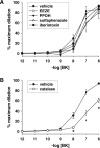Hydrogen peroxide inhibits cytochrome p450 epoxygenases: interaction between two endothelium-derived hyperpolarizing factors
- PMID: 17975109
- PMCID: PMC2364729
- DOI: 10.1161/CIRCRESAHA.107.159129
Hydrogen peroxide inhibits cytochrome p450 epoxygenases: interaction between two endothelium-derived hyperpolarizing factors
Abstract
The cytochrome P450 epoxygenase (CYP)-derived metabolites of arachidonic acid the epoxyeicosatrienoic acids (EETs) and hydrogen peroxide (H2O2) both function as endothelium-derived hyperpolarizing factors (EDHFs) in the human coronary microcirculation. However, the relative importance of and potential interactions between these 2 vasodilators remain unexplored. We identified a novel inhibitory interaction between CYPs and H2O2 in human coronary arterioles, where EDHF-mediated vasodilatory mechanisms are prominent. Bradykinin induced vascular superoxide and H2O2 production in an endothelium-dependent manner and elicited a concentration-dependent dilation that was reduced by catalase but not by 14,15-epoxyeicosa-5(Z)-enoic acid (EEZE), 6-(2-propargyloxyphenyl)hexanoic acid, sulfaphenazole, or iberiotoxin. However, in the presence of catalase, an inhibitory effect of these compounds was unmasked. In a tandem-bioassay preparation, application of bradykinin to endothelium-intact donor vessels elicited dilation of downstream endothelium-denuded detectors that was partially inhibited by donor-applied catalase but not by detector-applied EEZE; however, EEZE significantly inhibited dilation in the presence of catalase. EET production by human recombinant CYP 2C9 and 2J2, 2 major epoxygenase isozymes expressed in human coronary arterioles, was directly inhibited in a concentration-dependent fashion by H2O2 in vitro, as observed by high-performance liquid chromatography (HPLC); however, EETs were not directly sensitive to oxidative modification. H2O2 inhibited dilation to arachidonic acid but not to 11,12-EET. These findings suggest that an inhibitory interaction exists between 2 EDHFs in the human coronary microcirculation. CYP epoxygenases are directly inhibited by H2O2, and this interaction may modulate vascular EET bioavailability.
Figures






References
-
- Shimokawa H, Yasutake H, Fujii K, Owada MK, Nakaike R, Fukumoto Y, Takayanagi T, Nagao T, Egashira K, Fujishima M, Takeshita A. The importance of the hyperpolarizing mechanism increases as the vessel size decreases in endothelium-dependent relaxations in rat mesenteric circulation. J Cardiovasc Pharmacol. 1996;28:703–711. - PubMed
-
- Campbell WB, Gebremedhin D, Pratt PF, Harder DR. Identification of epoxyeicosatrienoic acids as endothelium-derived hyperpolarizing factors. Circ Res. 1996;78:415–423. - PubMed
-
- Fisslthaler B, Popp R, Kiss L, Potente M, Harder DR, Fleming I, Busse R. Cytochrome P450 2C is an EDHF synthase in coronary arteries. Nature. 1999;401:493–497. - PubMed
-
- Gauthier KM, Deeter C, Krishna UM, Reddy YK, Bondlela M, Falck JR, Campbell WB. 14,15-Epoxyeicosa-5(Z)-enoic acid: a selective epoxyeicosatrienoic acid antagonist that inhibits endothelium-dependent hyperpolarization and relaxation in coronary arteries. Circ Res. 2002;90:1028–1036. - PubMed
Publication types
MeSH terms
Substances
Grants and funding
LinkOut - more resources
Full Text Sources

